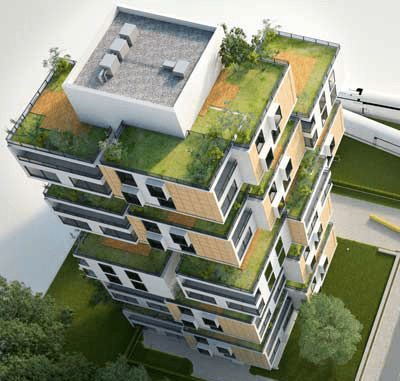Jeslu Celine Jacob
Indian Institute of Technology (IIT),
Kharagpur, India
Corresponding Author: jeslu@iitkgp.ac.in
Debapratim Pandit
Indian Institute of Technology (IIT), Kharagpur, India
Joy Sen
Indian Institute of Technology (IIT), Kharagpur, India
Cite this article
Highlights
- Need to integrate micro-zoning, thermal zoning and spatial planning of open-plan offices
- Protocols for micro-zoning outlined
- Planned micro-zones save 44% of HVAC energy consumption
Abstract
Air-conditioning energy consumed in buildings can be reduced by cooling only occupied regions. With modern open-plan offices being adaptable with flexible work hours, there is a need to virtually divide thermal zones based on varying thermal requirements. Micro-Zonal Occupant-Centric Control (MZOCC) saves HVAC energy by creating micro-comfort zones around occupants through independent diffuser control. However, research gaps exist between thermal zoning for HVAC design and micro-zoning. There is a lack of clarity on the method of micro-zoning and factors to be considered, such as size and shape of micro-zones. The aim of this study is to delineate protocols for micro-zoning and evaluate the benefits of planned micro-zones. Characteristics of existing Indian open-plan offices are studied, and a method for micro-zoning is delineated. Results indicate that planned micro-zoning saves 44% of energy. The micro-zonal layout acts as the starting point for optimising diffuser allocation and airflow control, which will further improve energy savings.
References
- H. Alsaad and C. Voelker, “Performance assessment of a ductless personalized ventilation system using a validated cfd model,” J Build Perform Simul, vol. 11, no. 6, pp. 689-704, 2018. https://doi.org/10.1080/19401493.2018.1431806
- J. Kaczmarczyk, A. Melikov, Z. Bolashikov, L. Nikolaev, and P. O. Fanger, “Human response to five designs of personalized ventilation,” HVAC and R Research, vol. 12, no. 2, pp. 367-384, 2006. https://doi.org/10.1080/10789669.2006.10391184
- B. Yang and S. C. Sekhar, “The influence of evenly distributed ceiling mounted personalized ventilation devices on the indoor environment,” International Journal of Ventilation, vol. 7, no. 2, pp. 99-112, 2008. https://doi.org/10.1080/14733315.2008.11683803
- S. Nagarathinam, H. Doddi, A. Vasan, V. Sarangan, P. Venkata Ramakrishna, and A. Sivasubramaniam, “Energy efficient thermal comfort in open-plan office buildings,” Energy Build, vol. 139, pp. 476-486, 2017. https://doi.org/10.1016/j.enbuild.2017.01.043
- P. Zhou, G. Huang, and Z. Li, “Demand-based temperature control of large-scale rooms aided by wireless sensor network: Energy saving potential analysis,” Energy Build, vol. 68, no. PARTA, pp. 532-540, 2014. https://doi.org/10.1016/j.enbuild.2013.10.005
- J. A. Gärtner, F. Massa Gray, and T. Auer, “Assessment of the impact of HVAC system configuration and control zoning on thermal comfort and energy efficiency in flexible office spaces,” Energy Build, vol. 212, 2020. https://doi.org/10.1016/j.enbuild.2020.109785
- J. C. Jacob, D. Pandit, and J. Sen, “An explorative study on transient cooling pattern and energy efficiency while using micro-zonal Occupant-centric control,” Architectural Engineering and Design Management, 2022. https://doi.org/10.1080/17452007.2022.2049439
- J. C. Jacob, D. Pandit, and J. Sen, “Energy-saving potential in Indian open-plan offices using Micro-Zonal Occupant Centric Control (MZOCC),” Energy Build, vol. 282, p. 112799, Mar. 2023. https://doi.org/10.1016/j.enbuild.2023.112799
- R. Rawal, M. Schweiker, O. B. Kazanci, V. Vardhan, Q. Jin, and L. Duanmu, “Personal comfort systems: A review on comfort, energy, and economics,” Energy and Buildings, vol. 214. Elsevier Ltd, p. 109858, May 01, 2020. https://doi.org/10.1016/j.enbuild.2020.109858
- S. Schiavon, A. K. Melikov, and C. Sekhar, “Energy analysis of the personalized ventilation system in hot and humid climates,” Energy Build, vol. 42, no. 5, pp. 699-707, May 2010. https://doi.org/10.1016/j.enbuild.2009.11.009
- M. Veselý and W. Zeiler, “Personalized conditioning and its impact on thermal comfort and energy performance – A review,” Renewable and Sustainable Energy Reviews. 2014. https://doi.org/10.1016/j.rser.2014.03.024
- A. K. Melikov, M. A. Skwarczynski, J. Kaczmarczyk, and J. Zabecky, “Use of personalized ventilation for improving health, comfort, and performance at high room temperature and humidity,” Indoor Air, vol. 23, no. 3, pp. 250-263, Jun. 2013. https://doi.org/10.1111/ina.12012
- J. Niu, N. Gao, M. Phoebe, and Z. Huigang, “Experimental study on a chair-based personalized ventilation system,” Build Environ, vol. 42, no. 2, pp. 913-925, Feb. 2007. https://doi.org/10.1016/j.buildenv.2005.10.011
- A. K. Melikov, R. Cermak, and M. Majer, “Personalized ventilation: Evaluation of different air terminal devices,” Energy Build, vol. 34, no. 8, pp. 829-836, 2002. https://doi.org/10.1016/S0378-7788(02)00102-0
- R. Cermak, M. Majer, and a. K. Melikov, “Measurements and Prediction of Inhaled Air Quality with Personalized Ventilation,” 2002, pp. 1054-1059.
- A. K. Melikov, “Personalized ventilation,” Indoor Air, Supplement, vol. 14, no. SUPPL. 7, pp. 157-167, 2004. https://doi.org/10.1111/j.1600-0668.2004.00284.x
- M. P. Andersen et al., “Well-connected microzones for increased building efficiency and occupant comfort,” BuildSys 2015 – Proceedings of the 2nd ACM International Conference on Embedded Systems for EnergyEfficient Built, no. November, pp. 121-122, 2015. https://doi.org/10.1145/2821650.2830312
- M. P. Bivolarova, A. K. Melikov, M. ; Kokora, and Z. D. Bolashikov, “Local cooling of the human body using ventilated igeria in hospitals,” APA, 2014.
- W. Wu and Z. Lin, “An experimental study of the influence of a walking occupant on three air distribution methods,” Build Environ, vol. 85, pp. 211-219, 2015. https://doi.org/10.1016/j.buildenv.2014.12.009
- F. M. Gray, T. Auer, J. Gärtner, F. Massa Gray, and T. Auer, “Flexible Office Buildings – The Effect of Space Layout Design and Zoning Strategies on Thermal Comfort and Energy Demand,” in bauSiM 2018 Modellierung und SiMulation iM lebenSzykluS von gebäuden, 2018, pp. 447-454.
- S. Nagarathinam, A. Vasan, V. Sarangan, R. Jayaprakash, and A. Sivasubramaniam, “Good set-points make good neighbors – User seating and temperature control in uberized workspaces,” BuildSys 2018 – Proceedings of the 5th Conference on Systems for Built Environments, pp. 144-147, 2018. https://doi.org/10.1145/3276774.3276781
- S. Nagarathinam, S. R. Iyer, A. Vasan, V. P. Ramakrishna, V. Sarangan, and A. Sivasubramaniam, “On the utility of occupancy sensing for managing HVAC energy in large zones,” e-Energy 2015 – Proceedings of the 2015 ACM 6th International Conference on Future Energy Systems, pp. 219-220, 2015. https://doi.org/10.1145/2768510.2770948
- S. Nagarathinam, A. Vasan, P. Venkata Ramakrishna, S. R. Iyer, V. Sarangan, and A. Sivasubramaniam, “Centralized management of HVAC energy in large Multi-AHU Zones,” BuildSys 2015 – Proceedings of the 2nd ACM International Conference on Embedded Systems for Energy-Efficient Built, pp. 157-166, 2015. https://doi.org/10.1145/2821650.2821655
- S. Nagarathinam, A. Vasan, V. Sarangan, R. Jayaprakash, and A. Sivasubramaniam, “User Placement and Optimal Cooling Energy for Co-working Building Spaces,” ACM Transactions on Cyber-Physical Systems, vol. 5, no. 2, pp. 1-24, 2021. https://doi.org/10.1145/3432818
- J. C. Jacob, D. Pandit, and J. Sen, “Reducing HVAC Energy Consumption Through Optimal Sub-Zoning Considering Occupant-Centric Control (OCC),” in 2022 International Conference on Efficient Building Design-Materials and HVAC Equipment Technologies, ASHRAE, 2022. [Online]. Available: https://www.ashrae.org/conferences/topical-conferences/the-fifth-international-conference-on-efficientbuilding-design
- F. A. D. Espinosa and L. R. Glicksman, “Effect of furniture and partitions on the surface temperatures in an office under forced flow,” Energy Build, vol. 147, pp. 155-165, 2017. https://doi.org/10.1016/j.enbuild.2017.04.067
- ASHRAE TC 1.6, “ASHRAE TERMINOLOGY of heating, Ventilation, Air Conditioning, and Refrigeration,” 1991.
- G. Ministry of power, “Energy Conservation Building Code,” 2007.
- T. Dogan, C. Reinhart, and P. Michalatos, “Automated multi-zone building energy model generation for schematic design and urban massing studies,” eSIM 2014, 2014.
- ASHRAE, ASHRAE handbook: Fundamentals. 2017.
- T. Dogan, C. Reinhart, and P. Michalatos, “Autozoner: an algorithm for automatic thermal zoning of buildings with unknown interior space definitions,” J Build Perform Simul, vol. 9, no. 2, pp. 176-189, Mar. 2016. https://doi.org/10.1080/19401493.2015.1006527
- A. Bres, F. Judex, G. Suter, and P. De Wilde, “Impact of zoning strategies for building performance simulation,” in Digital Proceedings of the 24th EG-ICE International Workshop on Intelligent Computing in Engineering 2017, 2017, pp. 35-44.
- M. Georgescu and I. Mezić, “Building energy igeria g: A systematic approach to zoning and model reduction using Koopman Mode Analysis,” Energy Build, vol. 86, no. February 2019, pp. 794-802, 2015. https://doi.org/10.1016/j.enbuild.2014.10.046
- J. Berquist, A. Tessier, W. O’brien, R. Attar, and A. Khan, “An investigation of generative design for heating, ventilation, and air-conditioning,” in Simulation Series, 2017, pp. 132-139. https://doi.org/10.22360/SimAUD.2017.SimAUD.018
- M. Shin and J. S. Haberl, “A procedure for automating thermal zoning for building energy simulation,” Journal of Building Engineering, vol. 46, p. 103780, Apr. 2022. https://doi.org/10.1016/j.jobe.2021.103780
- C. H. Pearson-Mims and V. I. Lohr, “Reported Impacts of Interior Plantscaping in Office Environments in the United States,” Horttechnology, vol. 10, no. 1, pp. 82-86, Jan. 2000. https://doi.org/10.21273/HORTTECH.10.1.82
- B. P. Haynes, “The impact of office layout on productivity,” Journal of Facilities Management, vol. 6, no. 3, pp. 189-201, Jul. 2008. https://doi.org/10.1108/14725960810885961
- S. Marzban, C. Candido, M. Mackey, L. Engelen, F. Zhang, and D. Tjondronegoro, “A review of research in activity-based working over the last ten years: lessons for the post-COVID workplace,” Journal of Facilities Management, vol. ahead-of-print, no. ahead-of-print, 2022. https://doi.org/10.1108/JFM-08-2021-0081
- M. A. Hassanain, “Analysis of factors influencing office workplace planning and design in corporate facilities,” Journal of Building Appraisal, vol. 6, no. 2, pp. 183-197, Sep. 2010. https://doi.org/10.1057/jba.2010.22
- L. W. C. Lai, K. W. Chau, S. N. G. Davies, and L. M. L. Kwan, “Open space office: A review of the literature and Hong Kong case studies,” Work, vol. 68, no. 3. 2021. https://doi.org/10.3233/WOR-203408
- M. A. Hassanain, A. K. Alnuaimi, and M. O. Sanni-Anibire, “Post occupancy evaluation of a flexible workplace facility in Saudi Arabia,” Journal of Facilities Management, vol. 16, no. 2, pp. 102-118, 2018. https://doi.org/10.1108/JFM-05-2017-0021
- B. Haynes and I. Price, “Quantifying the complex adaptive workplace,” Facilities, vol. 22, 2004. https://doi.org/10.1108/02632770410517906
- T. Sugiyama et al., “Office spatial design attributes, sitting, and face-to-face interactions: Systematic review and research agenda,” Building and Environment, vol. 187. 2021. https://doi.org/10.1016/j.buildenv.2020.107426
- A. Ezezue, E. Ibem, C. Odum, and B. Obiadi, “Architectural design interventions for sedentary behaviour among workers in office buildings in enugu, igeria,” Civil Engineering and Architecture, vol. 8, no. 6, 2020. https://doi.org/10.13189/cea.2020.080627
- L. Engelen, J. Chau, E. Bohn-Goldbaum, S. Young, D. Hespe, and A. Bauman, “Is Active Design changing the workplace? – A natural pre-post experiment looking at health behaviour and workplace perceptions,” Work, vol. 56, no. 2, 2017. https://doi.org/10.3233/WOR-172483
- H. Rasila and P. Rothe, “A problem is a problem is a benefit? Generation Y perceptions of open-plan offices,” Property Management, vol. 30, no. 4, pp. 362-375, Aug. 2012. https://doi.org/10.1108/02637471211249506
- B. Herbig, A. Schneider, and D. Nowak, “Does office space occupation matter? The role of the number of persons per enclosed office space, psychosocial work characteristics, and environmental satisfaction in the physical and mental health of employees,” Indoor Air, vol. 26, no. 5, pp. 755-767, Oct. 2016. https://doi.org/10.1111/ina.12263
- R. Singh, B. Ravache, and D. Sartor, “Building i[nnovation,” Lawrence Berkely National Laboratory, 2018.
- C. Habchi, W. Chakroun, S. Alotaibi, K. Ghali, and N. Ghaddar, “Effect of shifts from occupant design position on performance of ceiling personalized ventilation assisted with desk fan or chair fans,” Energy Build, vol. 117, pp. 20-32, Apr. 2016. https://doi.org/10.1016/j.enbuild.2016.02.006
- X. Shan and W. Z. Lu, “An integrated approach to evaluate thermal comfort in air-conditioned large-space office,” Sci Technol Built Environ, vol. 27, no. 4, pp. 436-450, 2020. https://doi.org/10.1080/23744731.2020.1796420
- Ashrae, ASHRAE Handbook Fundamentals 2017: Inch-Pound Edition. in ASHRAE Handbook Fundamentals Systems-International Metric System. American Society of Heating, Refrigerating and Air-Conditioning Engineers, 2017.
- L. Gu, “Airflow network modeling in energyplus,” in 10th International Building Performance Simulation Association Conference and Exhibition, Florida Solar Energy Center/University of Central Florida, 2007, pp. 964-971.
- J. C. Jacob, “Data: Energy estimation for micro-zonal divisions.” 2023. https://figshare.com/s/2d41b50951cceeac76a7

 Bishal Thapa
Bishal Thapa





 Fred Sherman
Fred Sherman Sumedha Malaviya
Sumedha Malaviya Satish Kumar
Satish Kumar












 The three main global energy concerns of providing access to modern energy, enhancing the security of the energy supply, and minimising the impact of energy systems on the climate have an impact on both national and international energy governance. To develop solutions that address the many facets of these difficulties, however, a variety of actors and stakeholders must be included due to the complexity of the energy challenges.
The three main global energy concerns of providing access to modern energy, enhancing the security of the energy supply, and minimising the impact of energy systems on the climate have an impact on both national and international energy governance. To develop solutions that address the many facets of these difficulties, however, a variety of actors and stakeholders must be included due to the complexity of the energy challenges. Cities are responsible for more than 70% of the world’s energy consumption and 40% to 50% of its greenhouse gas emissions. Managing increasing urbanisation is a challenge, and nations must deal with the effects it will have on the environment in terms of energy and climate.
Cities are responsible for more than 70% of the world’s energy consumption and 40% to 50% of its greenhouse gas emissions. Managing increasing urbanisation is a challenge, and nations must deal with the effects it will have on the environment in terms of energy and climate. Our transition to a future with lower carbon emissions depends heavily on buildings. They are our places of residence, rest, and employment; they also account for around one-third of the world’s greenhouse gas emissions and nearly 40% of the world’s energy usage.
Our transition to a future with lower carbon emissions depends heavily on buildings. They are our places of residence, rest, and employment; they also account for around one-third of the world’s greenhouse gas emissions and nearly 40% of the world’s energy usage.